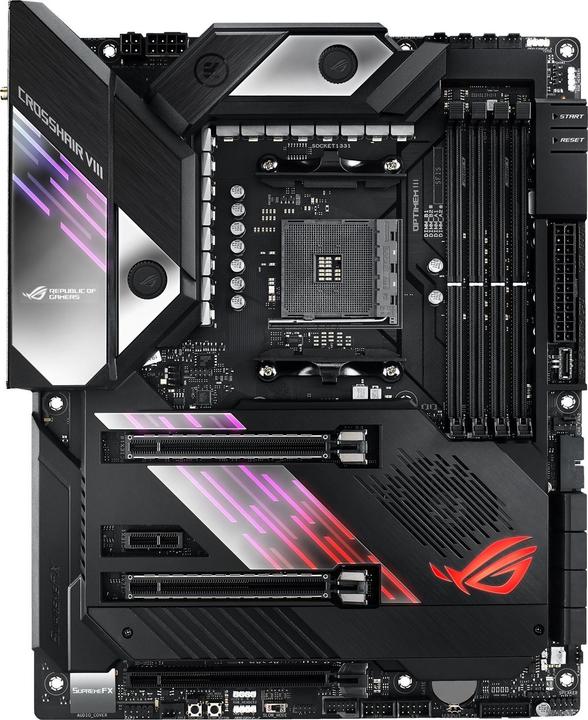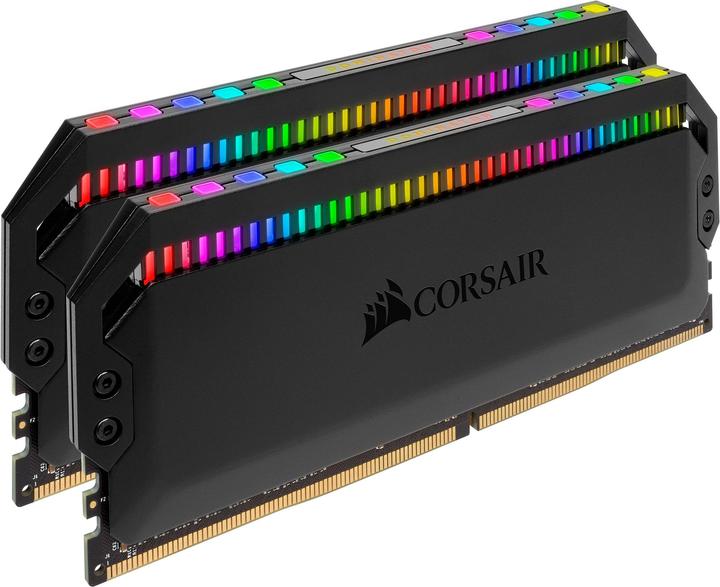

Sapphire Radeon RX 5700 XT Nitro+: Cool card at a good price
Now it's time for the custom designs: The Sapphire Radeon RX 5700 XT Nitro+ delivers better results than the reference card and impresses across the board.
The Sapphire Radeon RX 5700 XT Nitro+ is the company's flagship: three axial coolers, plenty of RGB blinking, a software-controlled dual BIOS switch, optional ARGB fans and a higher clock rate than the reference cards out of the box.

The card is tested on our DimasTech Easy V3.0 Benchtable with the following components:
You can read about our graphics card test methodology in the following article:
Facts and features
The Radeon RX 5700 XT is based on the Navi architecture, which is manufactured using the 7 nm production process and has new RDNA computing units. This is the biggest update to AMD's GPU design since the first Graphics CoreNext (GCN) architecture in 2013. In addition to the higher clock frequencies, RDNA is designed to achieve massive IPC improvements over GCN.

The centrepiece of the Radeon RX 5700 XT is the Navi 10 chip. There are 10.3 billion transistors on the 251 mm² chip. AMD uses cost-effective 256-bit GDDR6 memory. With a memory frequency of 14 Gbit/s, the card has a memory bandwidth of 448 GB/s. It also features PCIe Gen 4.0 x16 with full backwards compatibility for older PCIe generations.
| Graphics card | Shader units | ROPs | Base / boost clock (MHz) | Memory | Memory clock frequency (MHz) | GPU | Transistors |
|---|---|---|---|---|---|---|---|
| RX 5700 XT | 2560 | 64 | 1605 / 1755 | 8 GB, GDDR6, 256-bit | 1750 | Navi 10 | 10.3 million |
| Sapphire RX 5700 XT Nitro+ | 2560 | 64 | 1770 / 1905 | 8 GB, GDDR6, 256-bit | 1750 | Navi 10 | 10.3 million |
At 306 x 135 x 49 millimetres, the card is a real piece of furniture and is therefore unlikely to fit in every housing. It is connected with two 8-pin cables. Sapphire specifies 265 watts of power consumption and recommends at least a 600 watt power supply unit. The connections include two Display Ports 1.4a and two HDMI 2.0b.
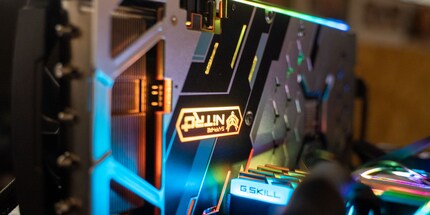
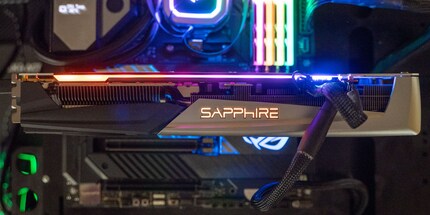
In terms of design, I consider the Sapphire Radeon RX 5700 XT Nitro+ to be one of the most beautiful cards I've ever seen. The silver backplate with RGB lettering looks great. I'm not a fan of RGB for my own builds, but Sapphire really put some thought into the Nitro+: Most of the RGB is on the backplate or front of the card. Most people install the card horizontally, so it makes sense to illuminate the backplate and front rather than the fans.
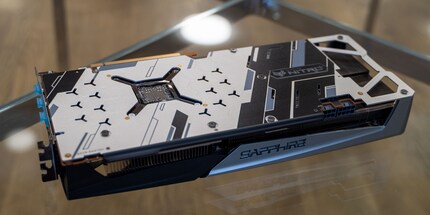
Synthetic benchmarks and temperatures
Here are the results of the Time Spy and Fire Strike benchmarks:
| Benchmark | Overall Score | Graphics Score
average FPS in Graphics Test 1 and 2 | Combined Score
average FPS |
|---|---|---|---|
| Fire Strike
(1080p, DirectX 11) | 22 644 | 27 003
126.96 FPS Test 1 109.19 FPS Test 2 | 9132
42.48 FPS |
| Fire Strike Ultra
(2160p, DirectX 11) | 6613 | 6627
34.21 FPS Test 1 24.89 FPS Test 2 | 3067
14.27 FPS |
| Time Spy
(1440p, DirectX 12) | 9416 | 9193
62.66 FPS Test 1 50.75 FPS Test 2 | n/a |
| Time Spy Extreme
(2160p, DirectX 12) | 4316 | 4080
29.07 FPS Test 1 21.77 FPS Test 2 | n/a |
The GPU reached a maximum temperature of 69° Celsius. On average, it ran at 67° Celsius. Compared to the reference model, this is very cool: it rose up to 83° Celsius. The cooling design of the Nitro+ is definitely noticeable.
But the Nitro+ doesn't just beat the reference model of the RX 5700 XT in terms of temperature. The Nitro+ is also ahead in the scores. Here is the performance comparison in graphical form.
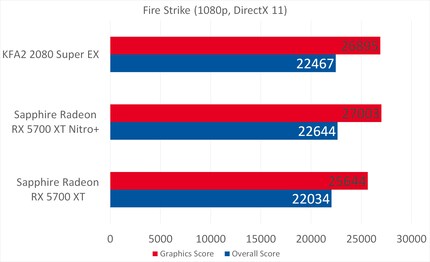



I'm currently looking for ways to test the graphics cards normalised by volume. That way I can make better statements about the cooling performance. Hopefully it will work for the next review. Then I'll do two tests with the synthetic benchmarks for better comparability: as before and normalised by volume.
Applications
In the synthetic benchmarks, the Nitro+ is always ahead of the reference card. I wonder what it looks like in the programmes.
Puget Systems Photoshop benchmark
The Photoshop benchmark uses the following reference workstation as the basis for calculating the scores:
- Intel Core i9 9900K 8 Core
- NVIDIA GeForce RTX 2080 8GB
- 64GB of RAM
- Samsung 960 Pro 1TB
The results of the reference workstation can be used to estimate how well other systems perform. Our test benchmark with the Sapphire Radeon RX 5700 XT Nitro+ achieves the following results:
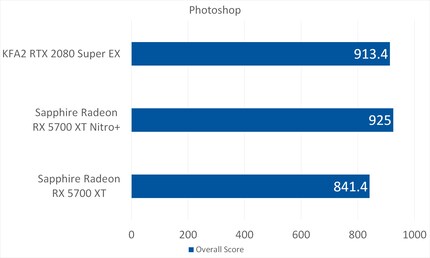
Here are the results in detail:
| Scores | Sapphire Radeon RX 5700 XT Nitro+ | Sapphire Radeon RX 5700 XT | KFA2 RTX 2080 Super EX | Reference workstation |
|---|---|---|---|---|
| Overall Score | 925 | 841.4 | 913.4 | 1000 |
| General Score | 92.5 | 79.1 | 87.1 | 100 |
| Filter Score | 89.8 | 84.4 | 94 | 100 |
| Photomerge Score | 97.9 | 93.7 | 94.5 | 100 |
| GPU Score | 90.8 | 86.5 | 97.6 | 100 |
As expected from the synthetic benchmarks, the Nitro+ outperforms the reference model. The difference is enormous and even the KFA2 RTX 2080 Super EX doesn't stand a chance against the Nitro+ in Photoshop.
Puget Systems Premiere Benchmark
In contrast to the Photoshop benchmark, our test benchmark does not compete against a reference workstation. With the Premiere benchmark from Puget Systems, the score is calculated relative to the frame rate of the test videos. If the test video has an FPS of 29.97 and the system renders it at 29.97 FPS, this means 100 points. If it is only 14.98 FPS, there are also only 50 points.
The benchmark runs media in the formats 4K H.264 with 150 Mbps in 8 bit (59.94 FPS), 4K ProRes 422 16 bit (59.94 FPS) and 4K RED (59.94 FPS), testing live playback in Adobe Premiere Pro and export. A value of 100 is the maximum for live playback, as Premiere cannot play back the media faster than specified. For export, on the other hand, over 100 points are feasible, as rendering is not limited to the FPS of the media.
In addition, ten ProRes 422 clips are provided with effects that place a heavy load on the graphics card. Puget Systems calls this 4K Heavy GPU Effects. These clips are then played back and exported in Premiere. The same exists for Heavy CPU Effects, with effects that place a heavy load on the CPU. The GPU value is particularly relevant for the graphics card reviews. The CPU values are nevertheless listed for the sake of completeness. Unfortunately, I have lost the overall scores from the Sapphire Radeon RX 5700 XT review. That's why I'm also listing the individual results for you.
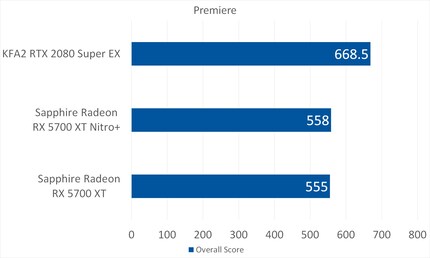
Here are the results in detail:
| Test | Sapphire Radeon RX 5700 XT Nitro+ | Sapphire Radeon RX 5700 XT | KFA2 RTX 2080 Super EX |
|---|---|---|---|
| Overall Score | 558 | 555 | 668.5 |
| Standard Live Playback Score | 52.6 | 51 | 69.4 |
| Export Score | 59 | 60 | 64.3 |
| 4K H.264 with 150 Mbps in 8 bit (59.94 FPS) | 57 Live Playback Score
87 Export Score | 57 Live Playback Score
88 Export Score | 56 Live Playback Score
91 Export Score |
| 4K ProRes 422 16 bit (59.94 FPS) | 72 Live Playback Score
93 Export Score | 72 Live Playback Score
94 Export Score | 99 Live Playback Score
93 Export Score |
| 4K RED (59.94 FPS) | 54 Live Playback Score
69 Export Score | 54 Live Playback Score
72 Export Score | 58 Live Playback Score
71 Export Score |
| 4K Heavy GPU Effects | 34 Live Playback Score
26 Export Score | 26 Live Playback Score
25 Export Score | 79 Live Playback Score
48 Export Score |
| 4K Heavy CPU Effects | 46 Live Playback Score
20 Export Score | 47 Live Playback Score
20 Export Score | 56 Live Playback Score
20 Export Score |
The Nitro+ beats the reference model - albeit only just. However, it is nowhere near the 2080 Super.
Puget Systems after-effects
In the Puget Systems benchmark of After Effects, the benchmark scores are structured similarly to Photoshop. The following reference workstation serves as the basis for calculating the scores:
- Intel Core i9 9900K
- 128 GB RAM
- NVIDIA GeForce RTX 2080 8GB
The results of the reference workstation can be used to estimate how well other systems perform. Our test benchmark with the Sapphire Radeon RX 5700 XT Nitro+ achieves the following results:
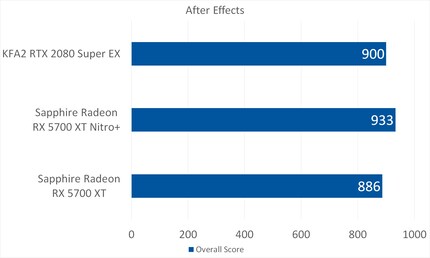
Here are the results in detail:
| Scores | Sapphire Radeon RX 5700 XT Nitro+ | Sapphire Radeon RX 5700 XT | KFA2 RTX 2080 Super EX | Reference workstation |
|---|---|---|---|---|
| Overall Score | 933 | 886 | 900 | 1000 |
| Render Score | 92.8 | 94.1 | 98.3 | 100 |
| Preview Score | 86.4 | 79.5 | 92.9 | 100 |
| Tracking score | 100.8 | 92.2 | 78.7 | 100 |
The Nitro+ also beats the two graphics cards tested so far in the After Effects benchmark. The gap in the overall score is between four per cent for the 2080 Super and five per cent for the reference 5700 XT.
Puget Systems Benchmark Resolve
The scores of the Resolve benchmark from Puget Systems are also based on a reference workstation. To determine the scores, codecs are rendered in 4K. The reference workstation is based on the following components:
- Intel Core i9 9900K
- A minimum of 32 GB RAM (not mentioned by Puget Systems)
- NVIDIA Titan RTX 24GB
In the 4K benchmark, I achieve the following results with our test benchmark and the Sapphire Radeon RX 5700 XT Nitro+:

Here are the results in detail:
| Test | Sapphire Radeon RX 5700 XT Nitro+ | Sapphire Radeon RX 5700 XT | KFA2 RTX 2080 Super EX | Reference workstation |
|---|---|---|---|---|
| 4K Average Results Overall Score | 714 | 725 | 947 | 1000 |
| 4K H264 150 Mbps 8 bit Codec Average Score | 71.1 | 70.4 | 93.6 | 100 |
| 4K Cinema Raw Light | 51.9 | 53.4 | 96.6 | 100 |
| 4K ProRes 422 | 71.1 | 72.9 | 95.9 | 100 |
| 4K ProRes 4444 | 74.4 | 78.4 | 93.6 | 100 |
| 4K RED | 88.4 | 87.6 | 93.9 | 100 |
In Resolve, the Nitro+ has to admit defeat to the reference model. With nine points - just under one per cent difference - it is a narrow victory for the Sapphire Radeon RX 5700 XT in the non-Nitro version. This is within the margin of error of benchmarks. The two cards deliver roughly the same performance.
Blender
The Blender benchmark renders six scenes: Barbershop Interior, BMW27, Classroom, Fishy Cat, Koro, and Pavilion Barcelona. The Nitro+ renders the six scenes in 24 minutes and 27 seconds. The reference model takes six seconds longer.
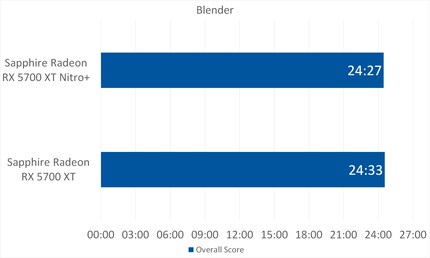
Virtual reality
When it comes to VR, I'm still looking for a programme to test games myself. Unfortunately, Nvidia's FCAT VR doesn't work for us. So here are the results from VRMark and Superposition from Unigine. Please let me know in the comments column if you know of another good tool for benching VR games.
| Benchmark | Sapphire Radeon RX 5700 XT Nitro+ | Sapphire Radeon RX 5700 XT | KFA2 RTX 2080 Super EX |
|---|---|---|---|
| VRMark Orange Room | 10 686
Points required: 5000 | 11 014
Points required: 5000 | 12 864
Points required: 5000 |
| VRMark Cyan Room | 9512
Points required: 3088 | 9026
Points required: 3088 | 11 504
Points required: 3088 |
| VRMark Blue Room | 2603
Points required: 2972 | 2484
Points required: 2972 | 3687
Points required: 2972 |
| Superposition VR Maximum
Oculus Rift | 10 000
FPS: min. 82.03, avg. 113.41, max. 152.28 | 9640
FPS: min. 87.66, avg. 108.45, max. 145.44 | 10 000
FPS: min. 81.51, avg. 133.03, max. 186.82 |
| Superposition VR Maximum
HTC Vive | 10 000
FPS: min. 102.04, avg. 128.86, max. 182.74 | 10 000
FPS: min. 96.97, avg. 122.92, max. 174.56 | 10 000
FPS: min. 86.27, avg. 144.13, max. 215.91 |
| Superposition VR Maximum
HTC Vive Pro | 10 000
FPS: min. 92.60, avg. 113.64, max. 150.65 | 9591
FPS: min 80.86, avg. 107.9, max. 145.02 | 10 000
FPS: min 81, avg. 132.67, max 190.23 |
The Nitro+ is behind the reference card in the Orange and Cyan Room tests, but the Nitro+ is faster in all other tests. Nevertheless, the card is more than powerful enough for VR games.
The games
Last but not least, our four game benchmarks. I'll list the average, minimum and maximum FPS. At the suggestion of user Mannyac, I will also provide you with the average frametime. This time even with graphics. I will provide a section of 2000 frames. As I am now recording with FRAPS instead of MSI Afterburner, the display is slightly different. Unfortunately, FRAPS does not work with Vulkan, which is why I have no graphics for "Strange Brigade". I will try Nvidia's FCAT for future reviews. However, the setup is time-consuming, which is why I'm still using FRAPS for the time being.
I'm rethinking the benchmark methodology for games based on the feedback from my Ryzen 3950X review. In future, I'll be focussing more on in-game benchmarks and will most likely remove "Crysis 3" and add "Deus Ex: Mankind Divided". Unlike Crysis, this has an in-game benchmark. I will only continue to use "Control" as before, as it is the game that utilises ray tracing the most. Unfortunately, there is no in-game benchmark. If I only have to start the in-game benchmark for most games in future, I'll consider recording even more games. You'll see in the next graphics card review. Here are the results of the Nitro+:
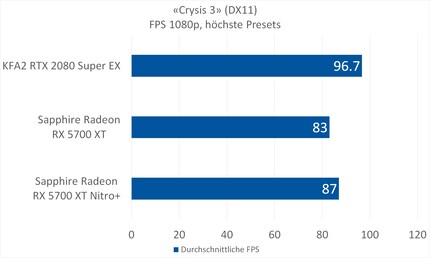













| Game | Sapphire Radeon RX 5700 XT Nitro+ | Sapphire Radeon RX 5700 XT | KFA2 RTX 2080 Super EX |
|---|---|---|---|
| "Crysis 3" (DX11)
FPS 1080p, highest presets | min. 43, average 87, max. 233
average frame time: 13.5 ms | min. 50.1, average 83, max. 134.9 | min. 50.4, average 96.7, max. 155.7
Frametime: 8-10 ms |
| "Crysis 3" (DX11)
FPS 1440p, highest presets | min. 31.4, average 44.7, max. 74.3
average frame time: 16.8 ms | min. 25.4, average 38.6, max. 66.6 | min. 38.7, average 50.6, max. 77.5
Frametime: 18-20 ms |
| "Control" (DX11)
FPS 1080p, highest presets | min. 36.9, average 61.2, max. 86.3
average frame time: 11.7 ms | min. 25.6, average 55.9, max. 84.1 | min. 56.4, average 108.5, max. 124.7
Frametime: 8-10 ms |
| "Control (DX11)
FPS 1440p, highest presets | min. 37, average 51, max. 58.7
average frame time: 24 ms | min. 28.7, average 37.2, max. 60.9 | min. 50.7, average 55.5, max. 63.2
Frametime: 17-19 ms |
| "Shadow of the Tomb Raider" (DX12)
FPS 1080p, highest presets | min. 94, average 118.4, max. 168
average frame time: 9.5 ms | min. 87, average 115, max. 183 | min. 96.4, average 122.4, max. 180.4
Frametime: 7-9 ms |
| "Shadow of Tomb Raider (DX12)
FPS 1440p, highest presets | min. 43, average 75.4, max. 87.8
average frame time: 16.2 ms | min. 48, average 61, max. 88 | min. 63.2, average 81.4, max. 97.4
Frametime: 14-16 ms |
| "Strange Brigade" (Vulkan)
FPS 1080p, highest presets | min. 120, average 193.4, max. 297.9
average frame time: 6.77 ms | min. 143, average 184, max. 229 | min. 177.5, average 263.1, max. 311.7
Frametime: 4-6 ms |
| "Strange Brigade" (Vulkan)
FPS 1440p, highest presets | min. 74, average 107.8, max. 221.7
average frame time: 10.3 ms | min. 81.7, average 102, max. 239 | min. 108.4, average 123.7, max. 147.8
Frametime: 7-9 ms |
The Nitro+ achieves better results across the board than the reference model. In certain games, the Nitro+ even comes close to the KFA2 2080 Super EX.
Conclusion
The Sapphire Radeon RX 5700 XT Nitro+ is a beast out of the box compared to the reference model. With the exception of Resolve, it is faster than the Sapphire Radeon RX 5700 XT in all respects. Not only that: the Nitro+'s cooler design is clearly better than that of the reference model.
The card is very well made and offers beautiful RGB effects. If you don't want to water cool it, the Nitro+ is definitely worth a look. If you consider the price of just under 499 francs, it is a no-brainer compared to the reference model from Sapphire for 465 francs.
From big data to big brother, Cyborgs to Sci-Fi. All aspects of technology and society fascinate me.
